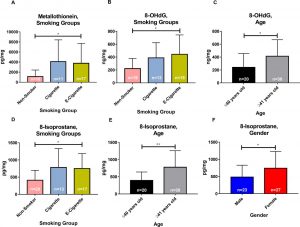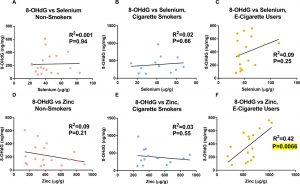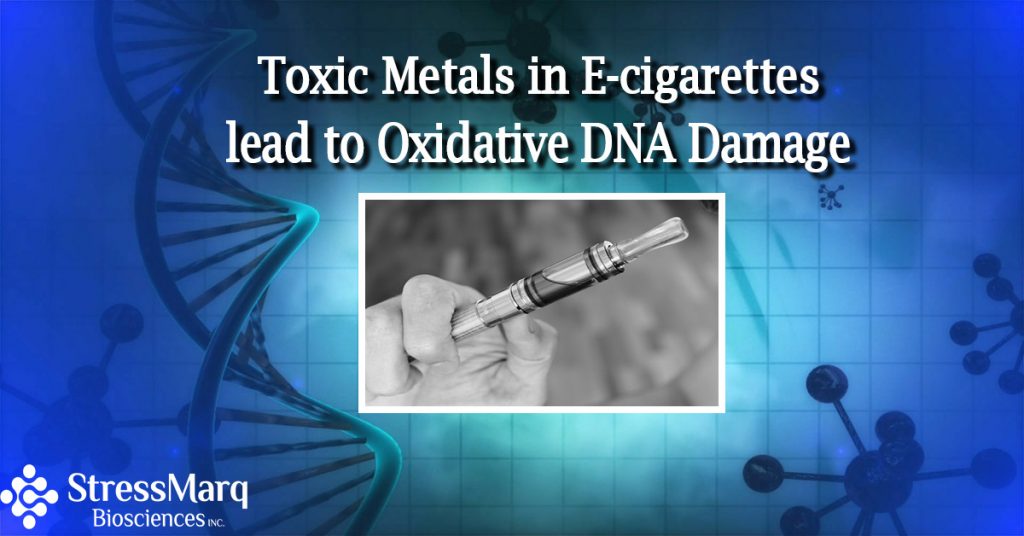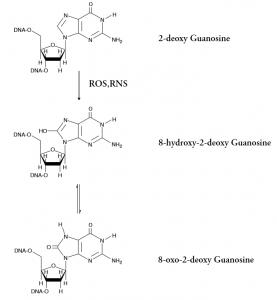Toxic Metals in E-cigarettes Lead to Oxidative DNA Damage
What are E-cigarettes?
Electronic cigarettes (e-cigarettes) are electronic devices that mimic cigarettes by heating a liquid and producing smoke. They have become very popular throughout the world especially by people who are trying to reduce or even quit smoking, as it is believed that they are safer and less harmful than conventional cigarettes. These devices use a battery and consist of an atomizer containing a solution of nicotine, flavors and other substances. The liquid in the atomizer is heated, turning into an aerosol which the user can inhale. Previous studies have demonstrated that e-cigarette aerosol contains chemicals (acrolein, formaldehyde and benzene)1, cytotoxic flavor chemicals (diacetyl, cinnamaldehyde)2,3, metals4,5 and free radicals6 that can cause serious diseases.

Electronic Cigarette Vapor . Lindsay Fox from Newport beach, United States / CC BY (https://creativecommons.org/licenses/by/2.0)
Study on e-cigarettes
Scientists from the University of California, Riverside, recently conducted research on e-cigarettes, published in the journal BMJ Open Respiratory Research. They examined and quantified urinary biomarkers of exposure, effect and potential harm in e-cigarette users, cigarette smokers and non- smokers and demonstrated the correlations between them.

Urinary metallothionein (pg/mg of creatinine), 8-OHdG (ng/mg of creatinine) and 8-isoprostane (pg/mg of creatinine) are significantly elevated in electronic cigarette users compared with non-smokers. (A) Metallothionein levels among the different smoking groups. (B) 8-OHdG concentration in the different smoking groups. (C) 8-OHdG concentration in the younger and older populations. (D) 8-isoprostane levels among the different smoking groups. (E) 8-Isoprostane levels in the younger and older populations. (F) 8-Isoprostane levels in men and women. Bars are the means and SD for each group. *P<0.05; **p<0.01.
What are biomarkers?
Biological markers or biomarkers are used in many scientific fields as indicators of normal or abnormal biological processes, conditions or diseases. They are biological molecules found in serum, other body fluids or tissues and are also used to evaluate how well the body responds to a treatment7.
Biomarkers of Exposure
Cotinine
Cotinine is an alkaloid found in tobacco and also a nicotine metabolite. It is used as a biomarker to evaluate exposure to tobacco smoke. Cotinine levels in serum and urine can be used to predict lung cancer risk in smokers8.
Metals
E-cigarettes contain an atomizer where the fluid is heated and the aerosol is produced. The metal components of the atomizer are also found in the aerosol. 11 metals are present in the aerosol and known to associate with metallothionein4,5. Specifically, selenium and zinc were significantly elevated in the urinary samples of e-cigarette users. It is well known that high levels of zinc can cause oxidative stress9 which was confirmed in the study as there was significant correlation between zinc and oxidative DNA damage.
Biomarkers of Effect
Metallothionein
Metallothionein (MTs) is a family of small cysteine-rich intracellular proteins that play important roles in metal homeostasis and protection against heavy metal toxicity, DNA damage, and oxidative stress. Metallothionein normally binds both physiological metals (zinc, copper, selenium) and xenobiotic heavy metals (cadmium, mercury, silver, arsenic) found in cigarette smoke and e-cigarette aerosol. In the study, metallothionein in the urine was significantly elevated in the e-cigarette group compared to non-smokers.
Biomarkers of Potential Harm
8- isoprostane
8-isoprostane is a prostaglandin formed by the free radical-catalyzed peroxidation of essential fatty acids. This lipid peroxidation biomarker is used widely in evaluating oxidative stress. The levels of this biomarker were higher in older e-cigarette and cigarette smokers which implies a greater risk for oxidative damage.
8-OHdG
8-hydroxy-2-deoxy Guanosine (8-OH-dG) is the major product of the oxidative damage of DNA by reactive oxygen and nitrogen species. 8-OHdG is an important biomarker and increased levels are associated with oxidative stress, cancer, aging, diabetes and hypertension.

Zinc concentrations (µg/g of creatinine) are significantly correlated to oxidative DNA damage in the electronic cigarette users. (A–C) Linear regression analysis comparing selenium (µg/g of creatinine) and 8-OHdG (ng/mg of creatinine) in urine of the non-smokers, cigarette smokers and electronic cigarette user groups. (D–F) Linear regression analysis comparing zinc (µg/g of creatinine) and 8-OHdG (ng/mg of creatinine) in urine in the non-smokers, cigarette smokers and electronic cigarette users groups.
In the present study, the researchers used StressMarq’s DNA Damage (8- OHdG) ELISA Kit (SKT-120) to determine biomarker 8-OHdG concentration in the urine samples. The results showed a significant elevation in the urinary levels of this biomarker in e-cigarette users compared to non- smokers as well as in older participants. It is clear that usage of e-cigarettes cause oxidative damage to DNA due to elevated levels of metals, especially zinc. These devices are not harmless and their prolonged use can lead to diseases like lung cancer, coronary heart disease, atherosclerosis, pulmonary fibrosis and many others10.
REFERENCES
- Levels of selected carcinogens and toxicants in vapour from electronic cigarettes. Goniewicz ML. et al. (2014) Tob Control 23:133–9.
- Identification of toxicants in cinnamon- flavored electronic cigarette refill fluids. Behar RZ. et al. (2014) Toxicology in Vitro 28:198–208.
- Distribution, quantification and toxicity of cinnamaldehyde in electronic cigarette refill fluids and aerosols. Behar RZ. et al. (2016)Tob Control 25:ii94–102.
- Metal and silicate particles including nanoparticles are present in electronic cigarette Cartomizer fluid and aerosol. Williams M. et al. (2013) PLoS One 8:e57987.
- Elements including metals in the atomizer and aerosol of disposable electronic cigarettes and electronic hookahs. Williams M. et al. (2017) PLoS One 12:e0175430.
- Highly reactive free radicals in electronic cigarette aerosols. Goel R. et al. (2015) Chem Res Toxicol 28:1675–7.
- Biomarkers Definitions Working Group (March 2001). “Biomarkers and surrogate endpoints: preferred definitions and conceptual framework”. Clin. Pharmacol. Ther. (Review). 69 (3): 89–95.
- Urinary Cotinine Is as Good a Biomarker as Serum Cotinine for Cigarette Smoking Exposure and Lung Cancer Risk Prediction, Thomas CE. et al. (2019)Cancer Epidemiol Biomarkers Prev EPI-19-0653
- The role of intracellular zinc release in aging, oxidative stress, and Alzheimer’s disease. McCord MC et al. (2014) Front Aging Neurosci 6
- Oxidative stress and human health. Rahman T. et al. (2012) Advanc Biosci Biotechnol 03:997–1019.



Leave a Reply